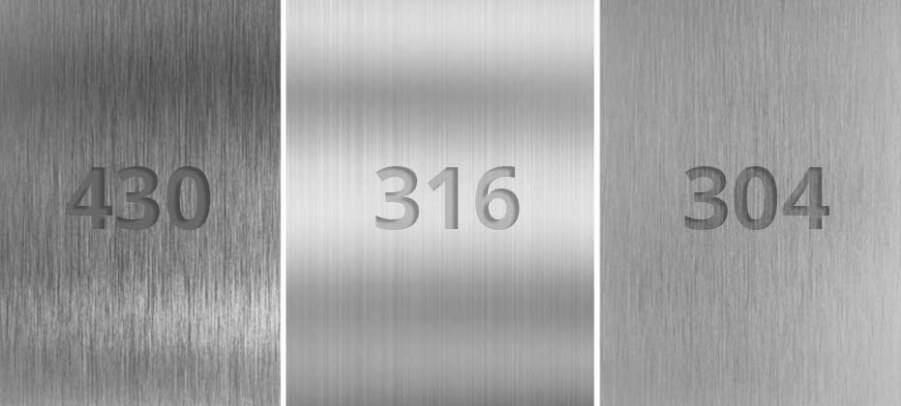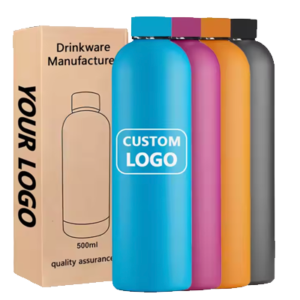Can We Use 430 Stainless Steel for Insulated Tumblers?
As insulated tumblers manufacturer, we often get questions about different stainless steel grades—especially from buyers trying to make sense of all those numbers. One common question we hear is:
“Does a higher number like 430 mean better quality?”
It’s a fair question—but the answer is not necessarily.
430 stainless steel, despite the higher number, it’s not considered a premium material. In fact, 430 is a ferritic stainless steel known for being magnetic and relatively low-cost. It’s widely used in kitchen settings—like backsplashes, oven panels, and some types of cutlery—where moisture exposure is limited and corrosion resistance isn’t a top concern.
So while 430 does have its uses, it’s not designed for high-performance drinkware. It lacks the durability and corrosion resistance needed in products like insulated tumblers, which have to deal with heat, liquid, and frequent handling. That’s why we don’t use 430 in our insulated bottle production.
Table of Contents
ToggleWhat Insulated Tumblers Need?
To understand why 430 stainless steel doesn’t cut it, we first need to look at what insulated tumblers demand from their materials—because it’s more than just a shiny finish.
At the heart of any insulated tumbler is vacuum insulation technology. This relies on two layers of stainless steel with a vacuum-sealed space in between to minimize heat transfer. For this to work, the steel must be durable, corrosion-resistant, and weldable—not just in theory, but in real-world, high-precision manufacturing.
On top of that, the material needs to handle hot coffee, acidic tea, fruit juice, milk—even dishwashers and travel wear and tear—without rusting, cracking, or leaching anything unwanted. That’s why 304 stainless steel (also known as 18/8) has become the go-to standard. It strikes the right balance between strength, safety, and long-term performance.
For manufacturers like us, it’s not just about whether a steel grade can be shaped into a cup. It’s about whether it can maintain its structure and quality over time, hold a vacuum seal, and meet international food safety standards. If a material falls short in any of these areas, it simply won’t make the cut—especially for products that carry your brand name.
Why 430 Stainless Steel Doesn’t Work for Insulated Tumblers
Now that we’ve covered what an insulated tumbler demands, it’s easy to see where 430 stainless steel falls short.
First, corrosion resistance is a major concern. 430 doesn’t contain nickel, which plays a key role in resisting rust—especially when the metal is exposed to heat, moisture, and acidity over time. In drinkware, where hot liquids, coffee acids, and fruit-based beverages are the norm, 430 simply can’t keep up. You’ll likely see discoloration, rust spots, or surface pitting develop much sooner than you’d expect.
Second, 430 is poorly suited for the vacuum insulation process. Creating a vacuum-sealed space between two stainless steel walls requires precise welding and stretching, both of which demand excellent formability and weldability. 430 tends to crack or warp under this kind of stress, making it unreliable for maintaining a long-lasting vacuum seal. And without a stable vacuum, you don’t have real insulation—just a metal cup with two layers.
Lastly, 430’s magnetic properties may raise red flags in certain markets, especially where non-magnetic grades like 304 are seen as a quality benchmark. While magnetism isn’t inherently bad, in the world of premium drinkware it can create the perception of lower quality—something we know brands and retailers are keen to avoid.
For these reasons, we’ve never used 430 stainless steel in our insulated tumbler production. It simply doesn’t meet the performance standards—or the expectations of our customers.
304 vs 316 vs 430 for Drinkware
When it comes to insulated tumblers, not all stainless steel is created equal. While 304 is the industry standard, 316 and 430 are often mentioned—either as upgrades or budget alternatives. Let’s break down how these materials actually compare in the real world of drinkware manufacturing.

304 stainless steel, also known as 18/8, is what we use in the majority of our insulated products. It contains both nickel and chromium, which gives it excellent corrosion resistance and long-term stability. It handles acidic drinks, hot liquids, and moisture without breaking down. It also offers great formability and weldability, making it ideal for vacuum insulation processes. In short, 304 strikes the best balance between cost, durability, and food safety.
316 stainless steel goes a step further. It includes molybdenum, which improves its resistance to salt, acids, and aggressive cleaning agents. It’s commonly used in marine environments—or in high-end drinkware designed for coffee, tea, and dairy-based drinks, where a higher level of chemical resistance is essential. It’s more expensive, but for certain niche markets or premium brands, it’s absolutely worth the investment.
Then there’s 430 stainless steel, which, as we covered earlier, falls short in almost every critical area. It doesn’t contain nickel, which means lower corrosion resistance. It’s harder to form and weld. And while it’s cheaper, the trade-offs in product lifespan, safety, and performance simply don’t make sense for insulated drinkware—especially if you’re building a brand that values quality.
So, whether you’re sourcing for an entry-level market or a premium audience, understanding the real-world behavior of these steel grades is key. A lower material cost might look attractive at first glance—but in our experience, it rarely pays off in the long run.
Which Steel Should You Choose?
If you’re sourcing insulated tumblers for your brand or retail line, material selection isn’t just a technical detail—it’s a quality decision that directly impacts user experience, product longevity, and even brand reputation.
For most general-purpose drinkware, 304 stainless steel remains the top choice. It offers the best overall performance-to-cost ratio, combining 18–20% chromium with 8–10% nickel. That formulation gives it corrosion resistance that’s about five times better than 430, along with a lower thermal conductivity—ideal for keeping drinks hot or cold for hours. Whether it’s hot water, tea, or milk, 304 handles it with ease and without risk of rust or leaching.
Looking to create a premium product line? That’s where 316 stainless steel comes in. By adding 2–3% molybdenum to the 304 base, it significantly improves resistance to acids, alkalis, and salt-based liquids—making it perfect for coffee, carbonated beverages, herbal infusions, or anything with a more complex chemical profile. It’s especially well-suited for professional users, health-conscious consumers, or families with infants, where long-term safety and hygiene are top priorities.
Of course, choosing the right material is only part of the process. Here are a few tips we always recommend to retailers and brand buyers:
Check the labeling: The product should clearly state the material grade (e.g., 304 or 316) along with “food contact safe.” Vague claims like “stainless steel” or “high-grade steel” don’t meet professional standards.
Choose a trusted water bottle manufacturer: Work with experienced producers like Haers, who test all incoming raw materials with spectrometers and conduct strict in-process checks—including corrosion soak testing and insulation performance validation.
Verify certifications: For domestic markets, make sure the product complies with GB 4806.9-2016, China’s national standard for food-contact metal. For exports, look for additional approvals like FDA (U.S.) to ensure broad compliance across regions.
Choosing the right stainless steel for your insulated tumblers isn’t just about materials—it’s about performance, brand reputation, and customer trust. While 430 stainless steel may look appealing due to its lower price, it simply can’t meet the demands of insulated drinkware.
At Haers, we’ve been manufacturing stainless steel drinkware for over two decades. We know how material choices impact real-world use—and we’re here to help you find the right solution for your market.
Looking to customize insulated tumblers in bulk?
Get in touch with our team today to explore material options, private labeling, and OEM/ODM services tailored to your brand.


